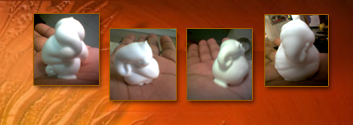             |
Philosophical Significance of Ganesha's form |
|
Ganesha's elephantine head and human body are explained as follows in the Mudgala Purana: Ganesha's human body representing 'tvam', His elephantine countenance representing 'tat' and their joining together signifies the nondifference of 'tvam' (You) and 'tat' (Brahman). Thus, the body of Ganesha is the visible representation of the highest reality, Brahman, realised from 'tat tvam asi'. Another explanation has it that Ganesha's head signifies Atman the Highest Reality, while the body below the neck represents mAyA, the principle of phenomenal existence. The Atman's involvement with the world is characterised by the assumption of mind and speech. Ganesha's ears, which appear like large winnowing baskets, have a philosophical significance too. Just as one uses a winnowing basket to separate grains from dirt, one must use discrimination (viveka) to separate the real (Brahman) from the unreal (mAyA) in life. Here the grains stand for Brahman and the dirt signifies mAyA. Or, Ganesha's ears indicate that such discrimination between Brahman and mAyA is to be gained by taking recourse to SravaNa or hearing. Listening to the scriptures from a Guru will lead to proper discrimination and Brahman realisation. |
| =================================== |